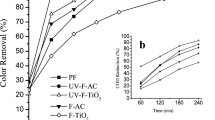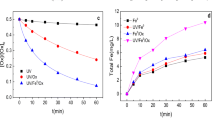Abstract
Iron-modified zeolitic tuff (Ze-Fe) and a composite (Ze-Fe(Fe-Cu)) in the presence of H2O2 with and without UV light were investigated for the removal of brilliant blue. The composite was synthesized from the ferric modified zeolitic tuff and reduction in-situ of Fe and Cu via sodium borohydride. The parameters considered in this study were pH, dose of H2O2, contact time, and initial concentration of brilliant blue. The kinetic results from Fenton and photo-Fenton processes were best adjusted to the second-order model. The degradation efficiencies were 98.8% for Ze-Fe and 95.94% for Ze-Fe(Fe-Cu) composite. The Ze-Fe(Fe-Cu) composite showed a higher degradation rate than Ze-Fe, since the equilibrium was reached for the composite in about 20 h and for the modified zeolite (Ze-Fe) in about 50 h. The adsorption capacities at equilibrium were 0.99 and 0.96 mg/g for Ze-Fe and Ze-Fe(Fe-Cu), respectively. The isotherm data of the adsorption of brilliant blue by both materials were best fitted to the Freundlich model, which indicates that the adsorption is carried out on heterogeneous surfaces.







Similar content being viewed by others
Data Availability
All data generated or analyzed during this study are included in this published article.
References
Ahmed, M. B., Zhou, J. L., Ngo, H. H., Guo, W., Johir, M. A. H., & Sornalingam, K. (2017). Single and competitive sorption properties and mechanism of functionalized biochar for removing sulfonamide antibiotics from water. Chemical Engineering Journal, 311, 348–358. https://doi.org/10.1016/j.cej.2016.11.106
Akgül, M. (2014). Enhancement of the anionic dye adsorption capacity of clinoptilolite by Fe3+-grafting. Journal of Hazardous Materials, 267, 1–8. https://doi.org/10.1016/j.jhazmat.2013.12.040
Almazán-Sánchez, P. T., Linares-Hernández, I., Solache-Ríos, M. J., & Martínez-Miranda, V. (2016). Textile wastewater treatment using iron-modified clay and copper-modified carbon in batch and column systems. Water, Air, and Soil Pollution, 227, 1–14. https://doi.org/10.1007/s11270-016-2801-7
Bahrami, M., & Nezamzadeh-Ejhieh, A. (2014). Effect of supporting and hybridizing of FeO and ZnO semiconductors onto an Iranian clinoptilolite nano-particles and the effect of ZnO/FeO ratio in the solar photodegradation of fish ponds waste water. Materials Science in Semiconductor Processing, 27, 833–840. https://doi.org/10.1016/j.mssp.2014.08.030
Cai, M. Q., Zhu, Y. Z., Wei, Z. S., Hu, J. Q., Pan, S. D., Xiao, R. Y., Dong, C. Y., & Jin, M. C. (2017). Rapid decolorization of dye Orange G by microwave enhanced Fenton-like reaction with delafossite-type CuFeO2. Science of the Total Environment, 580, 966–973. https://doi.org/10.1016/j.scitotenv.2016.12.047
Cao, Z., Yue, Y., Zhong, H., Qiu, P., Chen, P., Wen, X., Wang, S., & Liu, G. (2017). The cationic dye removal by novel Si—Zn composites prepared from zinc ash. Journal of the Taiwan Institute of Chemical Engineers, 71, 464–473. https://doi.org/10.1016/j.jtice.2016.12.005
Colomban, P., & Schreiber, H. D. (2005). Raman signature modification induced by copper nanoparticles in silicate glass. Journal of Raman Spectroscopy, 36, 884–890. https://doi.org/10.1002/jrs.1379
Corral-Capulin, N. G., Vilchis-Nestor, A. R., Gutiérrez-Segura, E., & Solache-Ríos, M. (2019). Comparison of the removal behavior of fluoride by Fe 3+ modified geomaterials from water. Applied Clay Science, 173, 19–28. https://doi.org/10.1016/j.clay.2019.03.003
Díaz-Nava, C., Olguín, M. T., Solache-Ríos, M., Alarcón-Herrera, M. T., & Aguilar-Elguezabal, A. (2009). Phenol sorption on surfactant-modified Mexican zeolitic-rich tuff in batch and continuous systems. Journal of Hazardous Materials, 167, 1063–1069. https://doi.org/10.1016/j.jhazmat.2009.01.138
Dinu, M. V., Lazar, M. M., & Dragan, E. S. (2017). Dual ionic cross-linked alginate/clinoptilolite composite microbeads with improved stability and enhanced sorption properties for methylene blue. Reactive & Functional Polymers, 116, 31–40. https://doi.org/10.1016/j.reactfunctpolym.2017.05.001
Ganiyu, S. O., de Araújo, C. E., Martínez-Huitle, C., & dos Santos, E. V. (2020). Electro-Fenton catalyzed by Fe-rich lateritic soil for the treatment of food colorant Bordeaux Red (E123): Catalyst characterization, optimization of operating conditions and mechanism of oxidation. Separation and Purification Technology., 242, 116776.
Gao, Y., Guo, Y., & Zhang, H. (2016). Iron modified bentonite: Enhanced adsorption performance for organic pollutant and its regeneration by heterogeneous visible light photo-Fenton process at circumneutral pH. Journal of Hazardous Materials, 302, 105–113. https://doi.org/10.1016/j.jhazmat.2015.09.036
Gutiérrez-Segura, E., Solache-Ríos, M., & Colín-Cruz, A. (2009). Sorption of indigo carmine by a Fe-zeolitic tuff and carbonaceous material from pyrolyzed sewage sludge. Journal of Hazardous Materials, 170, 1227–1235. https://doi.org/10.1016/j.jhazmat.2009.05.102
Gutiérrez-Segura, E., Solache-Ríos, M., Fall, C., & Colín-Cruz, A. (2012). Influence of the pH on distribution of denim blue in water Fe-Zeolitic tuff system. Separation Science and Technology, 47, 723–728. https://doi.org/10.1080/01496395.2011.620581
Hassan, M. E., Chen, Y., Liu, G., Zhu, D., & Cai, J. (2016). Journal of Water Process Engineering Heterogeneous photo-Fenton degradation of methyl orange by Fe 2 O 3 / TiO 2 nanoparticles under visible light. J. Water Process Eng., 12, 52–57. https://doi.org/10.1016/j.jwpe.2016.05.014
Hassan, H., & y Zahidi M.M. (2019). Decolorization of Acid Red 1 using natural zeolite via heterogeneous fenton-like oxidation. Journal of Physics: Conference Series, 1349, 012131.
Hernández-Hernández, K. A., Solache-Ríos, M., & Díaz-Nava, M. C. (2013). Removal of brilliant blue FCF from aqueous solutions using an unmodified and iron-modified bentonite and the thermodynamic parameters of the process. Water, Air, and Soil Pollution, 224, 1–11. https://doi.org/10.1007/s11270-013-1562-9
Ho, Y. S. (2006). Second-order kinetic model for the sorption of cadmium onto tree fern: A comparison of linear and non-linear methods. Water Research, 40, 119–125. https://doi.org/10.1016/j.watres.2005.10.040
Humelnicu, I., Băiceanu, A., Ignat, M. E., & Dulman, V. (2017). The removal of Basic Blue 41 textile dye from aqueous solution by adsorption onto natural zeolitic tuff: Kinetics and thermodynamics. Process Safety and Environment Protection, 105, 274–287. https://doi.org/10.1016/j.psep.2016.11.016
Jiménez-Cedillo, M. J., Olguín, M. T., & Fall, C. (2009). Adsorption kinetic of arsenates as water pollutant on iron, manganese and iron-manganese-modified clinoptilolite-rich tuffs. Journal of Hazardous Materials, 163, 939–945. https://doi.org/10.1016/j.jhazmat.2008.07.049
Karthikeyan, S., Pachamuthu, M. P., Isaacs, M. A., Kumar, S., Lee, A. F., & Sekaran, G. (2016). Cu and Fe oxides dispersed on SBA-15: A Fenton type bimetallic catalyst for N, N-diethyl-p-phenyl diamine degradation. Applied Catalysis b: Environmental, 199, 323–330. https://doi.org/10.1016/j.apcatb.2016.06.040
Lara-Vásquez, E. J., Solache-Riós, M., & Gutiérrez-Segura, E. (2016). Malachite green dye behaviors in the presence of biosorbents from maize (Zea mays L.), their Fe-Cu nanoparticles composites and Fe-Cu nanoparticles. Journal of Environmental Chemical Engineering, 4, 1594–1603. https://doi.org/10.1016/j.jece.2016.02.008
Pinedo-Hernández, S., Gutiérrez-Segura, E., Solache-Ríos, M., & Colín-Cruz, A. (2017). Properties of carbonaceous materials from sewage sludge to remove organic matter. Phenol as a particular case. Desalination and Water Treatment, 72, 126–135. https://doi.org/10.5004/dwt.2017.20633
Pinedo-Hernández, S., Sánchez-Mendieta, V., Gutiérrez-Segura, E., & Solache-Ríos, M. (2019). Efficient removal of brilliant blue by clinoptilolite tuff modified with Fe3+ and Fe–Cu nanoparticles. Desalin. Water Treat. 144. https://doi.org/10.5004/dwt.2019.23623
Rodriguez Peña, M., Barrera, D. C., & E., Comps. (2020). Procesos de oxidación avanzada en el tratamiento de agua (p. 239). Universidad Autónoma del Estado de México.
Shahwan, T., Abu Sirriah, S., Nairat, M., Boyaci, E., Eroĝlu, A. E., Scott, T. B., & Hallam, K. R. (2011). Green synthesis of iron nanoparticles and their application as a Fenton-like catalyst for the degradation of aqueous cationic and anionic dyes. Chemical Engineering Journal, 172, 258–266. https://doi.org/10.1016/j.cej.2011.05.103
Soler, M.A.G., & Qu, F. (2012). Raman spectroscopy of iron oxide nanoparticles. In: Challa S.S. R. Kumar. (Ed.), Raman spectroscopy for nanomaterials characterization, Springer-Verlag Berlin Heidelberg, pp. 379–416. (Chapter 14). https://doi.org/10.1007/978-3-642-20620-7
Tekbaş, M., Yatmaz, H. C., & Bektaş, N. (2008). Heterogeneous photo-Fenton oxidation of reactive azo dye solutions using iron exchanged zeolite as a catalyst. Microporous and Mesoporous Materials, 115, 594–602. https://doi.org/10.1016/j.micromeso.2008.03.001
Thiam, A., Sirés, I., & Brillas, E. (2015). Treatment of a mixture of food color additives (E122, E124 and E129) in different water matrices by UVA and solar photoelectro-Fenton. Water Research, 81, 178–187. https://doi.org/10.1016/j.watres.2015.05.057
Torres-Pérez, J., Solache-Ríos, M., & Olguín, M. T. (2007). Sorption of azo dyes onto a Mexican surfactant-modified clinoptilolite-rich tuff. Separation Science and Technology, 42, 299–318. https://doi.org/10.1080/01496390601069879
Trujillo-Reyes, J., Sánchez-Mendieta, V., José Solache-Ros, M., & Colín-Cruz, A. (2012). Removal of remazol yellow from aqueous solution using Fe-Cu and Fe-Ni nanoscale oxides and their carbonaceous composites. Environmental Technology, 33, 545–554. https://doi.org/10.1080/09593330.2011.584571
Truskewycz, A., Shukla, R., & Ball, A. S. (2016). Iron nanoparticles synthesized using green tea extracts for the fenton-like degradation of concentrated dye mixtures at elevated temperatures. Journal of Environmental Chemical Engineering, 4, 4409–4417. https://doi.org/10.1016/j.jece.2016.10.008
Wang, Y., Zhao, H., & Zhao, G. (2015). Iron-copper bimetallic nanoparticles embedded within ordered mesoporous carbon as effective and stable heterogeneous Fenton catalyst for the degradation of organic contaminants. Applied Catalysis b: Environmental, 164, 396–406. https://doi.org/10.1016/j.apcatb.2014.09.047
Zanin, E., Scapinello, J., de Oliveira, M., Rambo, C. L., Franscescon, F., Freitas, L., de Mello, J. M. M., Fiori, M. A., Oliveira, J. V., & Dal Magro, J. (2017). Adsorption of heavy metals from wastewater graphic industry using clinoptilolite zeolite as adsorbent. Process Safety and Environment Protection, 105, 194–200. https://doi.org/10.1016/j.psep.2016.11.008
Funding
This research was funded by the CONACYT, project 254665 and scholarship grant 554061, granted to S. Pinedo-Hernández.
Author information
Authors and Affiliations
Corresponding author
Ethics declarations
Conflict of Interest
The authors declare no competing interests.
Additional information
Publisher's Note
Springer Nature remains neutral with regard to jurisdictional claims in published maps and institutional affiliations.
Rights and permissions
About this article
Cite this article
Pinedo-Hernández, S., Sánchez-Mendieta, V., Solache-Ríos, M. et al. Degradation of Brilliant Blue by Heterogeneous Fenton and UV-Fenton Processes. Water Air Soil Pollut 233, 264 (2022). https://doi.org/10.1007/s11270-022-05722-6
Received:
Accepted:
Published:
DOI: https://doi.org/10.1007/s11270-022-05722-6




